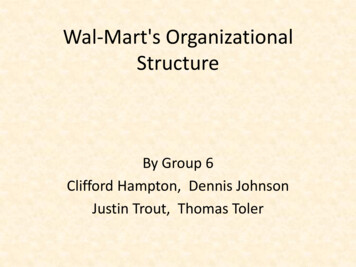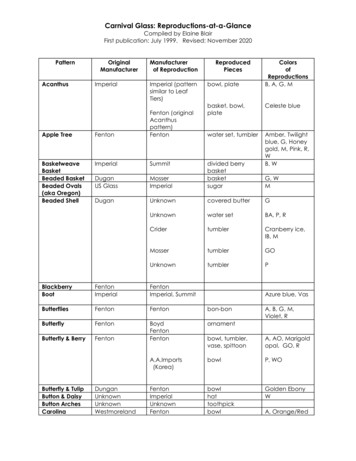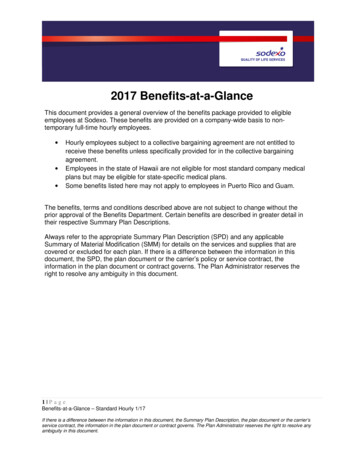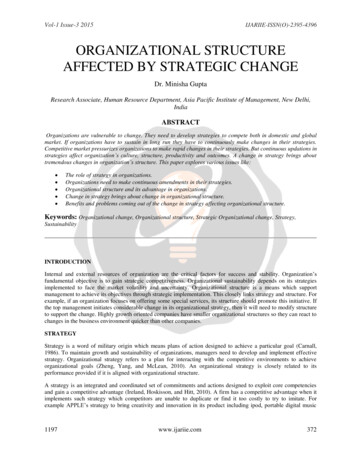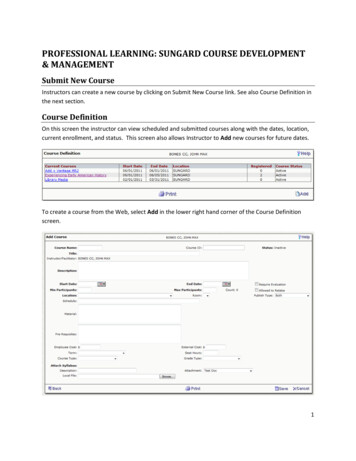
Transcription
AGRONOMYCourse Structure – at a GlanceCODECOURSE TITLECREDITSAGRON 501* MODERN CONCEPTS IN CROP PRODUCTION3 0AGRON 502* SOIL FERTILITY AND NUTRIENT MANAGEMENTAGRON 503* PRINCIPLES AND PRACTICES OF WEED MANAGEMENT2 12 1AGRON 504* PRINCIPLES AND PRACTICES OF WATER MANAGEMENT2 1AGRON 505 AGROMETEOROLOGY AND CROP WEATHER FORECASTING2 1AGRON 506* AGRONOMY OF MAJOR CEREALS AND PULSES2 1AGRON 507* AGRONOMY OF OILSEED, FIBRE AND SUGAR CROPS2 1AGRON 508 AGRONOMY OF MEDICINAL, AROMATIC AND UNDER2 1UTILIZED CROPSAGRON 509 AGRONOMY OF FODDER AND FORAGE CROPS2 1AGRON 510 AGROSTOLOGY AND AGROFORESTRY2 1AGRON 511 CROPPING SYSTEMS AND SUSTAINABLE AGRICULTURE2 0AGRON 512* DRYLAND FARMING AND WATERSHED MANAGEMENT2 1AGRON 513 PRINCIPLES AND PRACTICES OF ORGANIC FARMING2 1AGRON 591 MASTER’S SEMINAR1 0AGRON 599 MASTER’S RESEARCH20AGRON 601 CURRENT TRENDS IN AGRONOMY3 0AGRON 602 CROP ECOLOGY2 0AGRON 603 CROP PRODUCTION AND SYSTEM MODELING2 1AGRON 604 ADVANCES IN CROP GROWTH AND PRODUCTIVITY2 1AGRON 605 IRRIGATION MANAGEMENT2 1AGRON 606 ADVANCES IN WEED MANAGEMENT2 0AGRON 607 INTEGRATED FARMING SYSTEMS FOR SUSTAINABLEAGRICULTURE2 0AGRON 608 SOIL CONSERVATION AND WATERSHED MANAGEMENT2 1AGRON 609 STRESS CROP PRODUCTION2 1AGRON 691 DOCTORAL SEMINAR I1 0AGRON 692 DOCTORAL SEMINAR II1 0AGRON 699 DOCTORAL RESEARCH45*Compulsory for Master’s programme
Minor Departments9Soil SciencePlant PhysiologySupporting Departments5Soil SciencePlant PhysiologyStatistics and MathematicsNon credit compulsory coursesCODECOURSE TITLECREDITSPGS 501Library information services0 1PGS 501LIBRARY AND INFORMATION SERVICES0 1PGS 502TECHNICAL WRITING AND COMMUNICATION SKILLS0 1PGS 503(e-course)INTELLECTUAL PROPERTY AND ITS MANAGEMENT INAGRICULTURE1 0PGS 504BASIC CONCEPTS IN LABORATORY TECHNIQUES0 1PGS 505(e-course)AGRICULTURAL RESEARCH, RESEARCH ETHICS ANDRURAL DEVELOPMENT PROGRAMMES1 0PGS 506(e-course)DISASTER MANAGEMENT1 0
AGRON 501MODERN CONCEPTS IN CROP PRODUCTION3 0ObjectiveTo teach the basic concepts of soil management and crop production.TheoryUNIT ICrop growth analysis in relation to environment; Agro-ecological zones of India.UNIT IIQuantitative agro-biological principles and inverse yield nitrogen law; Mitscherlich yieldequation, its interpretation and applicability; Baule unit.UNIT IIIEffect of lodging in cereals; physiology of grain yield in cereals; optimization of plantpopulation and planting geometry in relation to different resources, concept of ideal planttype and crop modeling for desired crop yield.UNIT IVScientific principles of crop production; crop response production functions; concept of soilplant relations; yield and environmental stress.UNIT VIntegrated farming systems, organic farming, and resource conservation technology includingmodern concept of tillage; dry farming; determining the nutrient needs for yield potentialityof crop plants, concept of balance nutrition and integrated nutrient management; precisionagriculture.Suggested ReadingsBalasubramaniyan, P. & Palaniappan, S.P. 2001. Principles and Practices of Agronomy.Agrobios (India), Jodhpur, India.Fageria, N.K. 1992. Maximizing Crop Yields. Marcel Dekker Inc., New York.Havlin, J.L., Beaton, J.D., Tisdale, S.L. & Nelson, W.L. 2006. Soil Fertility and Fertilizers. 7thEd., Pearson/Prentice Hall, Upper Saddle River, New Jersey.Paroda, R.S. 2003. Sustaining our Food Security, Konark Publishers Pvt. Ltd., A-149, MainVikas Marg, New Delhi.Reddy, S.R. 2000. Principles of Crop Production. Kalyani Publishers, New Delhi.Sankaran, S. & Mudaliar, T.V.S. 1997. Principles of Agronomy. The Bangalore Printing &Publishers, Bangalore.Singh, S.S. 2006. Principles and Practices of Agronomy. Kalyani Publishers, New Delhi.Yellamanda Reddy, T. & Sankara Reddi, G.H. 2002. Principles of Agronomy, Kalyani Publishers,New Delhi.AGRON 502SOIL FERTILITY AND NUTRIENT MANAGEMENT2 1ObjectiveTo impart knowledge of fertilizers and manures as sources of plant nutrients and apprise aboutthe integrated approach of plant nutrition and sustainability of soil fertility.
TheoryUNIT ISoil fertility and productivity - factors affecting; features of good soil management; problemsof supply and availability of nutrients; relation between nutrient supply and crop growth;organic farming - basic concepts and definitions.UNIT IICriteria of essentiality of nutrients; Essential plant nutrients – their functions, nutrientdeficiency symptoms; transformation and dynamics of major plant nutrients.UNIT IIIPreparation and use of farmyard manure, compost, green manures, vermicompost,biofertilizers and other organic concentrates their composition, availability and cropresponses; recycling of organic wastes and residue management.UNIT IVCommercial fertilizers; composition, relative fertilizer value and cost; crop response todifferent nutrients, residual effects and fertilizer use efficiency, fertilizer mixtures and grades;agronomic, chemical and physiological methods of increasing fertilizer use efficiency; nutrientinteractions.UNIT VTime and methods of manures and fertilizers application; foliar application and its concept;relative performance of organic and inorganic manures; economics of fertilizer use; integratednutrient management; use of vermincompost and residue wastes in crops.PracticalDetermination of soil pH, Determination of EC, Determination of organic Carbon, Determinationof total N and available N in soils, Determination of P in soils, Determination of K in soils,Determination of S in soils, Determination of total N in plants, Determination of total P in plants,Determination of total K in plants, Determination of total S in plants, Interpretation of interactioneffects, Computation of economic and yield optimaSuggested ReadingssBrady, N.C. & Weil, R.R 2002. The Nature and Properties of Soils. 13th Ed, Prentice Hall, UpperSaddle River, New Jersey.Havlin, J.L., Tisdale, S.L., Beaton, J.D., & Nelson, W.L. 2006. Soil Fertility and Fertilizers.7thEd., Pearson/Prentice Hall, Upper Saddle River, New Jersey.Prasad, R. & Power J.F. 1997. Soil Fertility Management for Sustainable Agriculture. CRCPress-Lewis, Boca Raton, Florida.Reddy S.R. 2006. Principles of Crop Production, Kalyani Publishers, New Delhi.Reedy T.Y. and Reddi, G.H.S. 2002. Principles of Agronomy, Kalyani Publishers, NewDelhi, India.Tandon, H.L.S. 1992. Management of nutrient interactions in Agriculture. FDCO, New Delhi.Tandon, H.L.S. 1994. Fertilizers, Organic manures, Recyclable wastes and Biofertilizers–Components of Integrated Plant Nutrition. FDCO, New Delhi.
Fageria, N.K., Baligar, V.C. & Jones, C.A. 1991. Growth and Mineral Nutrition of Field Crops.Marcel Dekker Inc., New YorkYawalkar, K.S., Agarwal, J.P. & Bokde, S. 2000. Manures and Fertilizers. Agri-Horti Publishers,Nagpur.AGRON 503PRINCIPLES AND PRACTICES OF WEED MANAGEMENT2 1ObjectiveTo familiarize the students about the weeds, herbicides and methods of weed control.TheoryUNIT IWeed biology and ecology, crop-weed competition including allelopathy; principles andmethods of weed control and classification; weed indices.UNIT IIHerbicides introduction and history of their development; classification based on chemical,physiological application and selectivity; mode and mechanism of action of herbicides.UNIT IIIHerbicide structure - activity relationship; factors affecting the efficiency of herbicides;herbicide formulations, herbicide mixtures; herbicide resistance and management; weedcontrol through bio-herbicides, myco-herbicides and allelochemicals; Degradation ofherbicides in soil and plants; herbicide resistance in weeds and crops; herbicide rotation.UNIT IVWeed management in major crops and cropping systems; parasitic weeds; weed shifts incropping systems; aquatic and perennial weed control.UNIT VIntegrated weed management; cost : benefit analysis of weed management.PracticalIdentification of important weeds of different crops, Preparation of weed herbarium, Weed surveyin crops and cropping systems, Study of crop weed competition in on-going researchexperiments, Preparation of spray solutions of herbicides for high and low volume sprayers ,Use of various types of spray pumps and nozzles and calculation of swath width, Economicanalysis of weed management practices in different crops and cropping systems, Calculationof herbicide dose requirement, Study of herbicide residue analysis in plants and soils , Bioassay of herbicide residuesSuggested ReadingsAldrich RJ & Kramer RJ. 1997. Principles in Weed Management. Panima Publ.Ashton FM & Crafts AS. 1981. Mode of Action of Herbicides. 2nd Ed. Wiley Inter-Science.Gupta OP. 2007. Weed Management – Principles and Practices. Agrobios.Mandal RC. 1990. Weed, Weedicides and Weed Control - Principles and Practices. AgroBotanical Publ.
Rao VS. 2000. Principles of Weed Science. Oxford & IBH.Subramanian S, Ali AM & Kumar RJ. 1997. All About Weed Control. Kalyani.Zimdahl RL. 1999. Fundamentals of Weed Science. 2nd Ed. Academic Press.AGRON 504PRINCIPLES AND PRACTICES OF WATER MANAGEMENT2 1ObjectiveTo teach the principles of water management and practices to enhance the water productivity.TheoryUNIT IWater and its role in plants; water resources of India, major irrigation projects, extent ofarea and crops irrigated in India and different states.UNIT IISoil water movement in soil and plants; transpiration; soil-water-plant relationships; waterabsorption by plants; plant response to water stress, crop plant adaptation to moisturestress condition.UNIT IIISoil, plant and meteorological factors determining water needs of crops; scheduling, depthand methods of irrigation; microirrigation system; fertigation; management of water incontrolled environments and polyhouses.UNIT IVWater management of the crops and cropping systems; quality of irrigation water andmanagement of saline water for irrigation; water use efficiency.UNIT VExcess of soil water and plant growth; water management in problem soils; drainagerequirement of crops and methods of field drainage, their layout and spacing.PracticalMeasurement of soil water potential by Tensiometer, Measurement of soil water potential bypressure plate & pressure membrane apparatus , Construction of soil moisture characteristiccurves for soils representative to the region, Determination of infiltration rate by double ringinfiltrometer method, Determination of saturated and unsaturated hydraulic conductivity,Determination of reference crop evapotranspiration by Modified Penman, Penman Monteith &Pan evaporation method, Construction of crop coefficient curves for important crops of theregion, Determination of crop evapotranspiration, effective rainfall, leaching requirements andirrigation requirements, Measurement of irrigation water by 90 V-notch, Parshall flume andwater meter, Calculation of irrigation efficiency parameters, Study of sprinkler & drip irrigationsystem components, Determination of design emission uniformity in drip irrigation, Study of ongoing irrigation experimentsSuggested ReadingsLenka D. 1999. Irrigation and Drainage. Kalyani
Michael AM. 1978. Irrigation: Theory and Practice. Vikas Publ.Paliwal KV. 1972. Irrigation with Saline Water. IARI Monograph, New Delhi.Panda SC. 2003. Principles and Practices of Water Management. Agrobios.Prihar SS & Sandhu BS. 1987. Irrigation of Food Crops - Principles and Practices. ICAR.Reddy SR. 2000. Principles of Crop Production. Kalyani.Singh Pratap & Maliwal PL. 2005. Technologies for Food Security and Sustainable Agriculture.Agrotech Publ.AGRON 505AGROMETEOROLOGY AND CROP WEATHER FORECASTING2 1ObjectiveTo impart knowledge about agro-meteorology and crop weather forecasting to meet thechallenges of aberrant weather conditions.TheoryUNIT IAgro meteorology - aim, scope and development in relation to crop environment; compositionof atmosphere, distribution of atmosphericpressure and wind.UNIT IICharacteristics of solar radiation; energy balance of atmosphere system; radiation distributionin plant canopies, radiation utilization by field crops; photosynthesis and efficiency of radiationutilization by field crops; energy budget of plant canopies; environmental temperature: soil,air and canopy temperature.UNIT IIITemperature profile in air, soil, crop canopies; soil and air temperature effects on plantprocesses; environmental moisture and evaporation: measures of atmospheric temperatureand relative humidity vapor pressure and their relationships; evapo-transpiration andmeteorological factors determining evapotranspiration.UNIT IVModification of plant environment: artificial rain making, heat transfer, controlling heat load,heat trapping and shading; protection from cold, sensible and latent heat flux, controllingsoil moisture; monsoon and their origin, characteristics of monsoon; onset, progress andwithdrawal of monsoon; weather hazards, drought monitoring and planning for mitigation.UNIT VWeather forecasting in India – short, medium and long range; aerospace science andweather forecasting; benefits of weather services to agriculture, remote sensing; applicationin agriculture and its present status in India; atmospheric pollution and its effect on climateand crop production; climate change and its impact on agriculture.
Visit to agro-meteorological observatory and to record sun-shine hours, windvelocity, wind direction, relative humidity, soil and air temperature, evaporation,precipitation and atmospheric pressure Measurement of solar radiation outside and within plant canopy Measurement/estimation of evapo-transpiration by various methods Measurement/estimation of soil water balance Rainfall variability analysis Determination of heat-unit requirement for different crops Measurement of crop canopy temperature Measurement of soil temperatures at different depths Remote sensing and familiarization with agro-advisory service bulletins Study of synoptic charts and weather reports, working principle of automaticweather station Visit to solar observatorySuggested ReadingsChang Jan Hu 1968. Climate and Agriculture on Ecological Survey. Aldine Publ.Critchfield HJ.1995. General Climatology. Prentice Hall of India.Das PK.1968. The Monsoons. National Book Trust Publ.Lal DS.1998. Climatology. Sharda Pustak Bhawan.Lenka D.1998. Climate, Weather and Crops in India. Kalyani.Mavi H.S.1994. Introduction to Agro-meteorology. Oxford & IBH.Mavi HS & Tupper GJ. 2004. Agrometeorology: Principles andApplication of Climate Studies in Agriculture. Haworth Press.Menon PA.1991. Our Weather. National Book Trust Publ.Sahu DD. Agrometeorology and Remote Sensing: Principles and Practices.Agrobios.Variraju R & Krishnamurty 1995. Practical Manual on Agricultural Meteorology. Kalyani.Varshneya MC & Balakrishana Pillai P. 2003. Textbook of Agricultural Meteorology. ICAR.AGRON 506AGRONOMY OF MAJOR CEREALS AND PULSES2 1ObjectiveTo teach the crop husbandry of cereals and pulse crops.TheoryOrigin and history, area and production, classification, improved varieties, adaptability, climate,soil, water and cultural requirements, nutrition, quality components, handling and processing ofthe produce for maximum production ofUNIT IRabi cereals.
UNIT IIKharif cereals.UNIT IIIRabi pulses.UNIT IVKharif pulsesPracticalPlanning, seed bed preparation and layout of field experiments, Formulation of cropping schemesfor various farm sizes and calculation of cropping and rotational intensities, Interculturaloperations in different crops. Phenological studies at different growth stages of crops. Workingout growth indices (CGR, RGR, NAR and LAD), LER, aggressivity, relative crowding coefficient,monetary yield advantage and ATER of prominent intercropping systems of different crops.Judging of physiological maturity in different crops. Estimation of crop yield on the basis of yieldattributes. Estimation of protein content in pulses. Working out harvest index of variouscrops. Determination of cost of cultivation of different crops. Study of seed productiontechniques in various crops. Visit of field experiments on cultural, fertilizer, weed control and watermanagement aspects. Visit to nearby villages for identification of constraints in cropproduction.Suggested ReadingsDas, N.R. 2007. Introduction to Crops of India. Scientific publishers, Jodhpur, India.Rajendra Prasad. 2004. Text Book of Field Crop Production. Technical Editor, ICAR, NewDelhi.Reddy, S.R. 2004. Agronomy of Field Crops. Kalyani Publishers, New Delhi.De Datta, S.K. 1981. Principles and Practices Rice Production., John Willey & Sons, NewYork.Jeswani, L.M. & Baldev, B. 1997. Advances in Pulse Production Technology. ICAR, New Delhi.Yadav D S. 1992. Pulse Crops. Kalyani Publishers, New Delhi.Gururaj Hunsigi & Krishna, K. R. 1998. Science of Field Crop Production. Oxford & IBH publishingCo., Pvt., Ltd., New Delhi.Mahendra Pal, Jayanta, D. & Rai, R.K. 1996. Fundamentals of Cereal Crop Production. TataMcGraw Hill Publishing Co., New Delhi.Singh, C., Singh, P. & Singh, R. 2003. Modern Techniques of Raising Field Crops. Oxford &IBH Publishing Co., Pvt., Ltd., New Delhi.AGRON 507AGRONOMY OF OILSEED, FIBRE AND SUGAR CROPS2 1ObjectiveTo teach the crop husbandry of oilseed, fiber and sugar crops.TheoryOrigin and history, area and production, classification, improved varieties, adaptability, climate,soil, water and cultural requirements, nutrition quality component, handling and processing oftheproduceformaximumproductionof:
UNIT IRabi oilseeds – Rapeseed and mustard, linseed, etc.UNIT IIKharif oilseeds - Groundnut, sesame, castor, sunflower, soybean etc.UNIT IIIFiber crops - Cotton, jute, sunhemp etc.UNIT IVSugar crops – Sugar-beet and sugarcane.PracticalPlanning and layout of field experiments, Cutting of sugarcane setts, its treatment and methodsof sowing, tying and propping of sugarcane, Determination of cane maturity and calculation onpurity percentage, recovery percentage and sucrose content in cane juice phenological studiesat different growth stages of crop, Intercultural operations in different crops, Cotton seedtreatment, Working out growth indices (LER, CGR, RGR, NAR, LAD) aggressivity, relativecrowding coefficient, monetary yield advantage and ATER of prominent intercropping systems,Judging of physiological maturity in different crops and working out harvest index, Working outcost of cultivation of different crops, Estimation of crop yield on the basis of yield attributes,Formulation of cropping schemes for various farm sizes and calculation of cropping and rotationalintensities, Determination of oil content in oilseeds and computation of oil yield, Estimation ofquality of fibre of different fibre crops, Study of seed production techniques in various crops,Visit of field experiments on cultural, fertilizer, weed control and water management aspects,Visit to nearby villages for identification of constraints in crop productionSuggested ReadingsDas NR. 2007. Introduction to Crops of India. Scientific Publ.Das PC. 1997. Oilseed Crops of India. Kalyani.Lakshmikantam N. 1983. Technology in Sugarcane Growing. 2nd Ed.Oxford & IBH.Prasad, Rajendra. 2002. Text Book of Field Crop Production. ICAR.Singh C, Singh P & Singh R. 2003. Modern Techniques of Raising Field Crops. Oxford & IBH.Singh SS. 1998. Crop Management. Kalyani.AGRON 508AGRONOMY OF MEDICINAL, AROMATIC ANDUNDER-UTILIZED CROPS2 1ObjectiveTo acquaint students about different medicinal, aromatic and underutilized field crops, theirpackage of practices and processing.TheoryUNIT IImportance of medicinal and aromatic plants in human health, national economy andrelated industries, classification of medicinal and aromatic plants according to botanicalcharacteristicsanduses.
UNIT IIClimate and soil requirements; cultural practices; yield and important constituents ofmedicinal plants (Isabgol, Rauwolfia, Poppy, Aloe vera, Satavar, Stevia, Safed Musli,Kalmegh, Asaphoetida, Nux vomica, Rosadle etc).UNIT IIIClimate and soil requirements; cultural practices; yield and important constituents of aromaticplants (Citronella, Palmarosa, Mentha, Basil, Lemon grass, Rose, Patchouli, Geraniumetc.).UNIT IVClimate and soil requirements; cultural practices; yield of under-utilized crops (Rice bean,Lathyrus, Sesbania, Clusterbean, French bean, Fenugreek, Grain Amaranth, Coffee, Teaand Tobacco).PracticalIdentification of crops based on morphological and seed characteristics, Raising of herbariumof medicinal, aromatic and under-utilized plants, Quality characters in medicinal and aromaticplants, Methods of analysis of essential oil and other chemicals of importance in medicinal andaromatic plantsSuggested ReadingsChadha KL & Gupta R. 1995. Advances in Horticulture. Vol. II. Medicinal and Aromatic Plants.Malhotra Publ.Das NR. 2007. Introduction to Crops of India. Scientific Publ.Handa SS. 1984. Cultivation and Utilization of Medicinal Plants. RRL, CSIR, Jammu.Hussain A. 1984. Essential Oil Plants and their Cultivation. CIMAP, Lucknow.Hussain A. 1993. Medicinal Plants and their Cultivation. CIMAP, Lucknow.ICAR 2006. Hand Book of Agriculture. ICAR, New Delhi.Kumar N, Khader Md. Abdul, Rangaswami JBM & Irulappan 1997.Introduction to Spices, Plantation Crops, Medicinal and Aromatic Plants. Oxford & IBH.Prajapati ND, Purohit SS, Sharma AK & Kumar T. 2003. A Hand Book of Medicinal Plants: AComplete Source Book. Agrobios.Sharma R. 2004. Agro-Techniques of Medicinal Plants. Daya Publ. House.AGRON 509AGRONOMY OF FODDER AND FORAGE CROPS2 1ObjectiveTo teach the crop husbandry of different forage and fodder crops along with their processing.TheoryUNIT IAdaptation, distribution, varietal improvement, agro-techniques and quality aspects includinganti-quality factors of important fodder crops like maize, bajra, guar, cowpea, oats, barley,berseem,senji,lucerneetc.
UNIT IIAdaptation, distribution, varietal improvement, agro-techniques and quality aspects includinganti-quality factors of important forage crops/grasseslime, napier grass, Panicum,Lasiuras, Cenchrus etc.UNIT IIIYear-round fodder production and management, preservation and utilization of forage andpasture crops.UNIT IVPrinciples and methods of hay and silage making; chemical and biochemical changes,nutrient losses and factors affecting quality of hay and silage; use of physical and chemicalenrichments and biological methods for improving nutrition; value addition of poor qualityfodder.UNIT VEconomics of forage cultivation uses and seed production techniques.PracticalPractical raining of farm operations in raising fodder crops;, Canopy measurement, yield andquality estimation, viz. crude protein, NDF, ADF, lignin, silica, cellulose etc. of various fodderand forage crops, Anti-quality components like HCN in sorghum and such factors in othercrops, Hay and silage making and economics of their preparationSuggested ReadingsChatterjee BN. 1989. Forage Crop Production - Principles and Practices.Oxford & IBH.Das NR. 2007. Introduction to Crops of India. Scientific Publ.Narayanan TR & Dabadghao PM. 1972. Forage Crops of India. ICAR.Singh P & Srivastava AK. 1990. Forage Production Technology. IGFRI, Jhansi.Singh C, Singh P & Singh R. 2003. Modern Techniques of Raising Field Crops. Oxford & IBH.Tejwani KG. 1994. Agroforestry in India. Oxford & IBH.AGRON 510AGROSTOLOGY AND AGRO-FORESTRY2 1ObjectiveTo teach crop husbandry of different forage, fodder and agroforestry crops/trees along withtheir processing.TheoryUNIT IAgrostology: definition and importance; principles of grassland ecology: grassland ecology– community, climax, dominant species, succession, biotype, ecological status of grasslandsin India, grass cover of India; problems and management of grasslands.UNIT IIImportance, classification (various criteria), scope, status and research needs of pastures;pasture establishment, their improvement and renovation-natural pastures, cultivatedpastures;commonpasturegrasses.
UNIT IIIAgroforestry: definition and importance; agroforestory systems, agrisilviculture, silvipasture,agrisilvipasture, agrihorticulture, aquasilviculture, alley cropping and energy plantation.UNIT IVCrop production technology in agro-forestory and agrostology system; silvipastoral system:meaning and importance for wasteland development; selection of species, planting methodsand problems of seed germination in agro-forestry systems; irrigation and manuring inagro-forestry systems, associative influence in relation to above ground and undergroundinterferences; lopping and coppicing in agro-forestry systems; social acceptability andeconomic viability, nutritive value of trees; tender operation; desirable tree characteristics.PracticalPreparation of charts and maps of India showing different types of pastures and agro-forestrysystems, Identification of seeds and plants of common grasses, legumes and trees of economicimportance with reference to agro-forestry, Seed treatment for better germination of farmvegetation, Methods of propagation/planting of grasses and trees in silvipastoral system,Fertilizer application in strip and silvipastroal systems, After-care of plantation, Estimation ofprotein content in loppings of important fodder trees, Estimation of calorie value of wood ofimportant fuel trees, Estimation of total biomass and fuel wood, Economics of agro-forestry,Visit to important agro-forestry research stationsSuggested ReadingsChatterjee BN & Das PK. 1989. Forage Crop Production. Principles and Practices. Oxford &IBH.Dabadghao PM & Shankaranarayan KA. 1973. The Grass Cover in India. ICAR.Dwivedi AP. 1992. Agroforestry- Principles and Practices. Oxford & IBH.Indian Society of Agronomy. 1989. Agroforestry System in India. Research and Development,New Delhi.Narayan TR & Dabadghao PM. 1972. Forage Crop of India. ICAR, New Delhi.Pathak PS & Roy MM. 1994. Agroforestry System for Degraded Lands.Oxford & IBH.Sen NL, Dadheech RC, Dashora LK & Rawat TS. 2004. Manual of Agroforestry and SocialForestry. Agrotech Publ.Shah SA.1988. Forestry for People. ICAR.Singh Panjab, Pathak PS & Roy MM.1994. Agroforestry System for Sustainable Use. Oxford &IBH.Singh SP. 1994. Handbook of Agroforestry. Agrotech Publ.Solanki KR. 2000. Multipurpose Tree Species: Research, Retrospect and Prospects. Agrobios.Tejwani KG.1994. Agroforestry in India. Oxford & IBH.
AGRON 511CROPPING SYSTEMS AND SUSTAINABLE AGRICULTURE2 0ObjectiveTo acquaint the students about prevailing cropping systems in the country and practices toimprove their productivity.TheoryUNIT ICropping systems: definition, indices and its importance; physical resources, soil and watermanagement in cropping systems; assessment of land use.UNIT IIConcept of sustainability in cropping systems and farming systems, scope and objectives;production potential under monoculture cropping, multiple cropping, alley cropping,sequential cropping and intercropping, mechanism of yield advantage in intercroppingsystems.UNIT IIIAbove and below ground interactions and allelopathic effects; competition relations; multistoried cropping and yield stability in intercropping, role of non-monetary inputs and lowcost technologies; research need on sustainable agriculture.UNIT IVCrop diversification for sustainability; role of organic matter in maintenance of soil fertility;crop residue management; fertilizer use efficiency and concept of fertilizer use in intensivecropping system.UNIT VPlant ideotypes for drylands; plant growth regulators and their role in sustainability.Suggested ReadingsPalaniappan SP & Sivaraman K. 1996. Cropping Systems in the Tropics; Principles andManagement. New Age.Panda SC. 2003. Cropping and Farming Systems. Agrobios.Reddy SR. 2000. Principles of Crop Production. Kalyani.Sankaran S & Mudaliar TVS. 1997. Principles of Agronomy. The Bangalore Printing & Publ.Co.Singh SS. 2006. Principles and Practices of Agronomy. Kalyani.Tisdale SL, Nelson WL, Beaton JD & Havlin JL. 1997. Soil Fertility and Fertilizers. PrenticeHall.AGRON 512DRYLAND FARMING AND WATERSHED MANAGEMENT2 1ObjectiveTo teach the basic concepts and practices of dry land farming and soil moisture conservation.
TheoryUNIT IDefinition, concept and characteristics of dry land farming; dry land versus rainfed farming;significance and dimensions of dry land farming in Indian agriculture.UNIT IISoil and climatic parameters with special emphasis on rainfall characteristics; constraintslimiting crop production in dry land areas; types of drought, characterization of environmentfor water availability; crop planning for erratic and aberrant weather conditions.UNIT IIIStress physiology and resistance to drought, adaptation of crop plants to drought, droughtmanagement strategies; preparation of appropriate crop plans for dry land areas; midcontingent plan for aberrant weather conditions.UNIT IVTillage, tilth, frequency and depth of cultivation, compaction in soil tillage; concept ofconservation tillage; tillage in relation to weed control and moisture conservation; techniquesand practices of soil moisture conservation (use of mulches, kinds, effectiveness andeconomics); antitranspirants; soil and crop management techniques, seeding and efficientfertilizer use.UNIT VConcept of watershed resource management, problems, approach and components.PracticalSeed treatment, Seed germination and crop establishment in relation to soil moisture contentsStudy of moisture stress effects and recovery behaviour of important crops, Estimation ofmoisture index and aridity index, Spraying of antitranspirants and their effect on crops, Collectionand interpretation of data for water balance equations, Study of water use efficiency in differentcrops, Preparation of crop plans for different drought conditions, Study of field experimentsrelevant to dryland farming, Visit to dryland research stations and watershed projectsSuggested ReadingsDas NR. 2007. Tillage and Crop Production. Scientific Publishers.Dhopte AM. 2002. Agrotechnology for Dryland Farming. Scientific Publ.Dhruv Narayan VV. 2002. Soil and Water Conservation Research in India. ICAR.Gupta US. (Ed.). 19
agronomy of oilseed, fibre and sugar crops agronomy of medicinal, aromatic and under utilized crops agronomy of fodder and forage crops y and agroforestry cropping systems and sustainable agriculture d farming an watershed management principle sand practice of organic farming master’s seminar master
